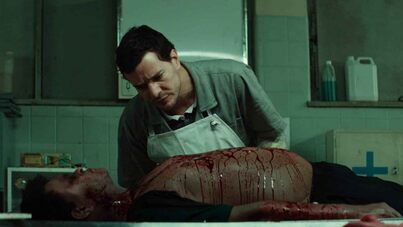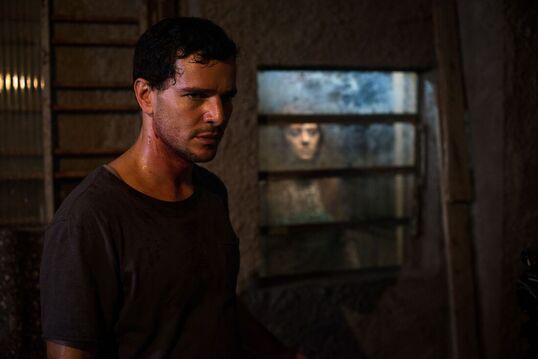 If you’ve ever wanted an incredibly dark, bloody, spiritual sequel to The Sixth Sense where little Haley Joel Osment grows up to be a disturbed mortician manipulating the dead and their secrets, then you’re going to want to see The Nightshifter… …Based on the book by Marco de Castro and directed by Dennison Ramalho (ABCs of Death 2 segment, “J is for Jesus”), with a script written by Ramalho and Cláudia Jouvin (Land of the Strong), The Nightshifter tells the strange, chilling story of Stênio (Daniel de Oliveira), a mortician who has the ability to communicate with the dead. When Stênio learns of a family betrayal from a corpse, he uses his power for a dark purpose, resulting in ghostly consequences that threaten to destroy his entire family. Ramalho creates an interesting world for viewers of The Nightshifter, one which I instantly fell in love with. Stênio is a man of the night, similar perhaps to Nic Cage’s character in Bringing Out the Dead. Though while Cage is a paramedic losing his mind over death and patients he couldn’t save, Stênio has a shockingly calm attitude towards death, as do those around him. When we first meet our hero (or is he?), we find Sténio joking around with paramedics about the dick size of a corpse, a refreshing change up from the classic eating a lunch over a dead body as we so often see in these films. Stênio has an eerily casual view of death, but is that because he’s so used to talking to corpses, or has years of conversing with the dead made him into a psychopath? That’s the road The Nightshifter sends us down, and what sets it apart from similar setups like The Sixth Sense. The Nightshifter does everything possible to make us feel as sorry for Stênio as we can before things take an ugly turn. His wife, Odete (Fabiula Nascimento) hates him, his kids barely know him, and he’s a poor bum who has trouble getting through the monotony of life, and really, don’t we all? Stênio and the characters he interacts with, such as meek waitress and friend, Lara (Bianca Comparato), all feel like true to life, down on their luck people that we can relate to. And then Ramalho sucker punches us right in the gut. Without spoiling anything, let’s just say that Stênio decides to use his (thankfully unexplained) power to talk to the dead for evil rather than good. The moment is actually quite shocking, managing to drastically shift from a dark but fun story about a guy talking to the corpses of gangsters, to a sinister tale of revenge and regret. Stênio takes such an evil turn as a character in fact, that Ramalho arguably pushes the audience a little too far in accepting him as the hero of this story after we’re asked to once again sympathize for Stênio as the haunting plot takes over. I don’t know about you, but I like my characters flawed and complicated, and even though it’s understandable if you can’t quite buy into Stênio after his brief though devilish turn, Oliveira gives such an outstanding, grieving performance, that it can be difficult not to. Maybe that’s because the true horror of the film is one most of us can relate to: the collapse of family. If you’ve ever watched your parents go through a divorce like I have, then you’ll see that The Nightshifter perfectly captures and exaggerates that experience on screen. Ramalho expresses the destruction of the family unit through grimy tones of brown and green, coupled with a relentless atmosphere exemplified by Stênio’s paranoia. The Nightshifter walks a fine line between various types of ghost stories, from talking to the dead to phantasmic revenge to Stênio taking a slight Amityville Horror turn, like going mad and forcing his way through a room full of razor wire that was never really there. Rather than focus on any one thing, Ramalho plays with all of these tropes, which admittedly comes off as a little messy and jarring at times, but it’s also accurate to the pain and confusion that occurs when kids watch their parents go through a separation, as Stênio is experiencing with Odete. Adding to the stark terror of the themes and frightening haunting is The Nightshifter’s unflinching approach to gore. Ramalho doesn’t go crazy with arms being sawed off or that sort of thing, but the film, like Stênio himself, looks at blood with a surgical eye, which makes for some pretty queasy viewing. The effects in The Nightshifter are phenomenal, and Ramalho is completely unafraid to make the viewer feel a little sticky. Thanks to Stênio’s questionable sanity, the skilled director is also able to have some fun, occasionally stepping away from the too-real flapping skin of a cut-open human ribcage to give us talking heads in jars. What’s impressive there is that Ramalho never breaks the unsettling tone of the film, giving moments like that a disturbing edge, which could be funny in different hands, but illicit bubbling dread here. The Nightshifter’s transformative and somewhat inconsistent script, as well as Stênio’s terrible actions are, without a doubt, going to turn off some viewers, and for good reason. But that’s exactly what Ramalho is going for here. Life and death isn’t black and white. Both are complex pieces of Stênio’s daily struggle, and Ramalho presents them with the sort of care and attention necessary to give us something which, on the surface, is a combination of various tropes, but becomes something wholly unique because of it. The Nightshifter begins haunting Shudder tomorrow. By Matt Konopka
0 Comments
Leave a Reply. |
Archives
March 2023
|


 RSS Feed
RSS Feed